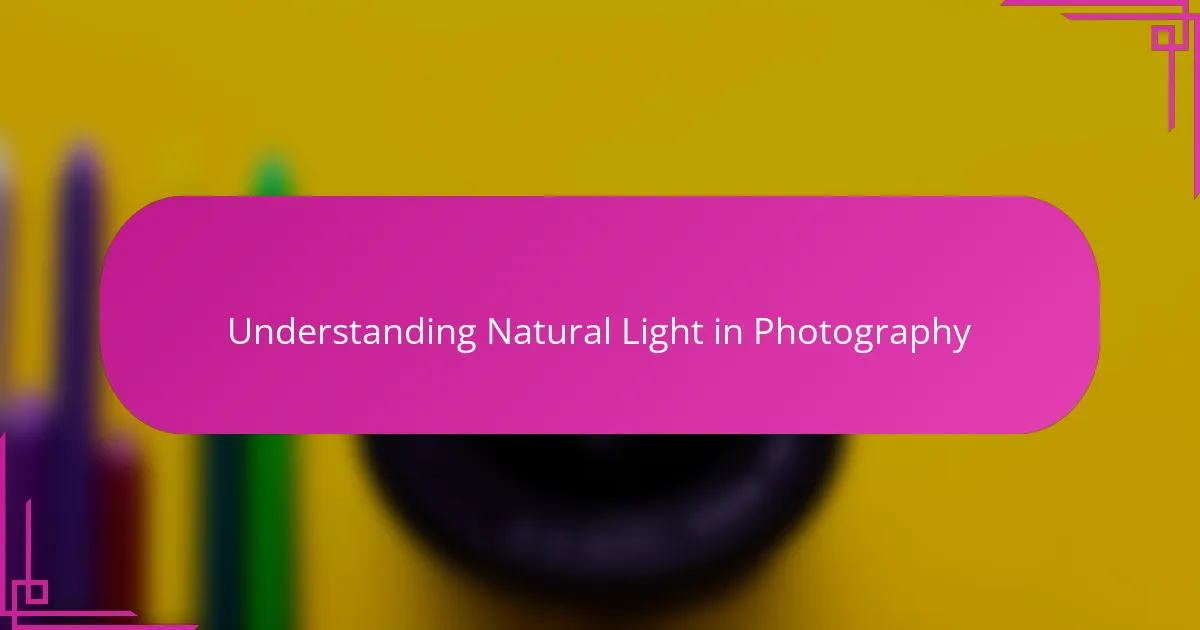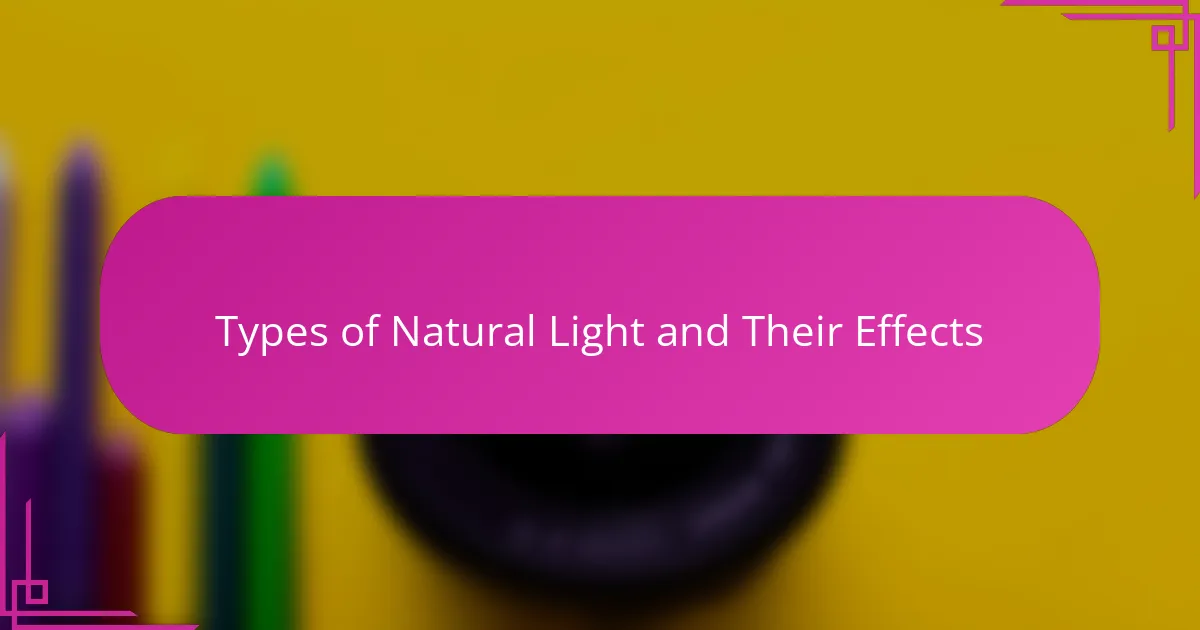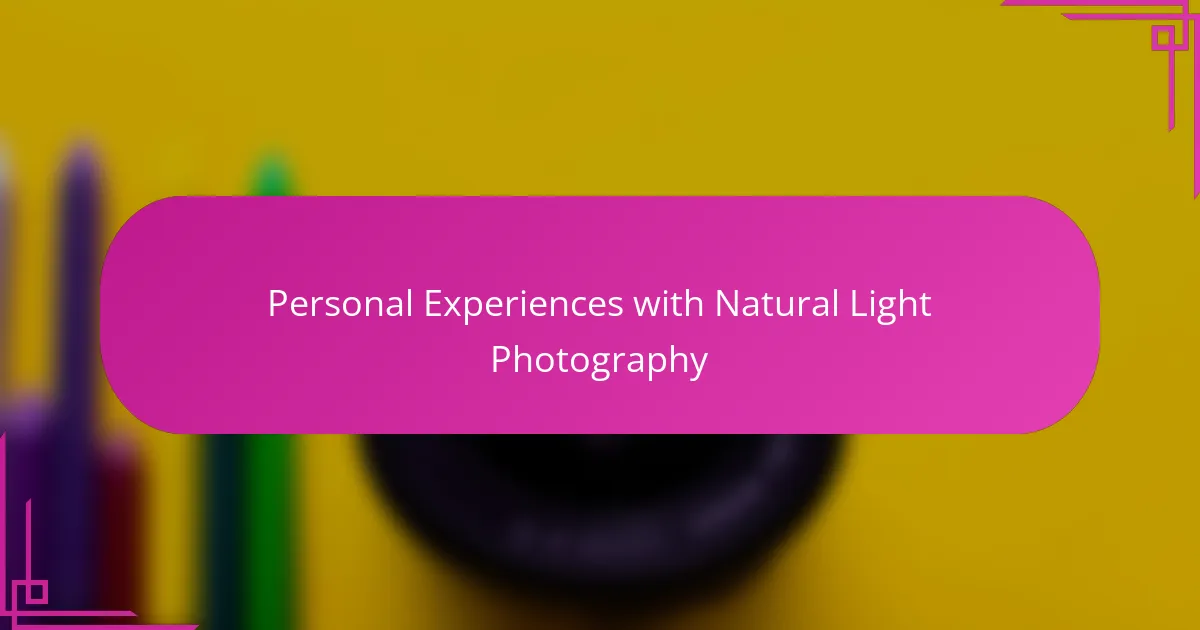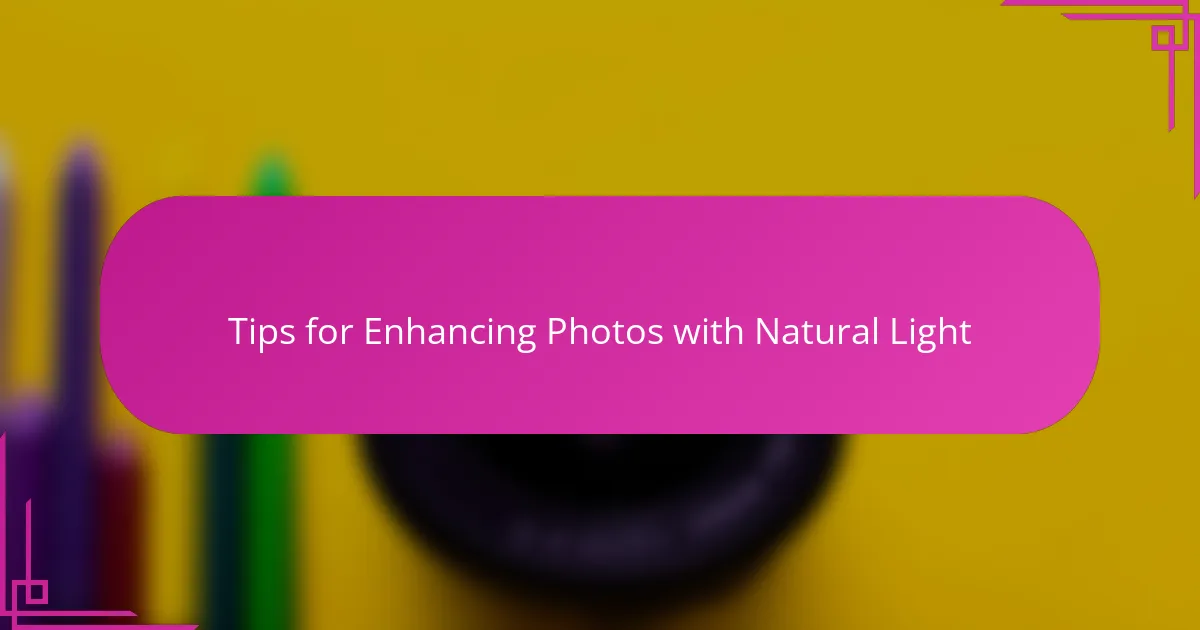Key takeaways
- Understanding the quality of natural light at different times of the day enhances photography, with early mornings offering soft light and midday providing bold contrasts.
- Utilizing equipment like cameras with wide dynamic ranges and fast prime lenses captures the nuances of natural light effectively.
- Techniques such as using reflectors and repositioning subjects can significantly improve the outcome of natural light photography.
- Being patient and adaptable to changing light conditions allows photographers to capture stunning images that reflect the magic of their environment.

Understanding Natural Light in Photography
Natural light is more than just illumination—it’s the mood setter in every frame. I remember my first shoot at golden hour; the way the light wrapped around my subject felt almost magical. Have you ever noticed how sunlight can reveal textures and colors that artificial light just can’t replicate?
The quality of natural light changes throughout the day, and understanding this rhythm is key. Early mornings offer soft, diffused light that creates a calm, dreamy feel, while midday sunlight can be harsh but perfect for high-contrast, dramatic shots. It’s a dance with time—knowing when to shoot means harnessing nature’s own photographer’s toolkit.
What fascinates me most is how shadows and highlights sculpt the image when using natural light. Instead of fighting the light, I let it guide the composition. Don’t you find that playing with natural light makes every photo a unique conversation between the environment and your vision?

Types of Natural Light and Their Effects
Soft light, like that found on overcast days or during the golden hour, has always felt like a gentle companion to my camera. I often rely on it when I want to bring out the subtle details and skin tones without harsh shadows. Have you noticed how this type of light wraps around your subject, giving scenes a warm, inviting glow that’s hard to replicate artificially?
Then there’s midday light, which hits with a bold intensity. I used to shy away from shooting under this bright, direct sun because of the strong shadows and contrast it creates. But over time, I learned to embrace it for its dramatic effect—those crisp shadows and vivid highlights can add a powerful sense of depth and emotion to your photos, especially in urban or architectural settings.
Finally, the cool, diffused light at dawn or dusk has a quiet beauty that never fails to inspire me. I recall one early morning shoot where the soft blue tones and long shadows imparted a serene, almost ethereal quality to the landscape. It makes me wonder, isn’t it amazing how just a shift in the sun’s position transforms the entire mood of a scene?

Equipment for Capturing Natural Light
When it comes to capturing natural light, the camera itself plays a crucial role. I’ve found that using a camera with a wide dynamic range helps preserve the delicate balance between shadows and highlights. Have you ever struggled with blown-out skies or lost details in the shadows? A camera that handles these nuances lets you fully embrace the light’s drama.
Lenses matter just as much. I often reach for a fast prime lens because its wide aperture allows more light to hit the sensor, making the most of those fleeting golden hour moments. Plus, the shallow depth of field it creates really emphasizes the softness and warmth of natural light, giving my portraits a dreamy quality I cherish.
Beyond camera and lens, I rely on simple tools like reflectors to bounce natural light exactly where I want it. It’s amazing how a few adjustments with a reflector can brighten a shadowed face without introducing artificial light. Have you ever noticed how subtle changes in light direction can completely transform the emotion of a photo? That’s the magic equipment helps me capture.

Techniques to Maximize Natural Light Use
Maximizing natural light starts with knowing how to position your subject. I learned early on that placing a person near a large window during the afternoon floods the scene with soft, flattering light that effortlessly enhances skin tones. Have you experimented with turning your subject slightly toward or away from the light source? Even small adjustments can make shadows dance differently and add depth without extra gear.
Using reflectors or white boards to bounce light has been a simple game-changer for me. There was one shoot where the late afternoon sun created harsh shadows on my model’s face, but a quick repositioning of a reflector brought back the glow and softened the contrast instantly. It makes me wonder—how often do we overlook these subtle tricks that don’t involve buying new equipment but simply working smarter with what nature gives us?
Timing is everything when working with natural light. I now always plan shoots around the “golden hour” because the warm, diffused light seems to paint every detail with a gentle brush. Have you noticed how this light reduces harsh contrasts and creates those magical, elongated shadows? Capturing these fleeting moments requires patience, but the rewards are well worth the wait.

Personal Experiences with Natural Light Photography
I’ve often found that natural light brings out a spontaneity in my photography that artificial setups just can’t match. One afternoon, while shooting in a sunlit park, the way the light filtered through the leaves created unpredictable patterns that shifted every few seconds—it felt like the scene was alive, and I was just there to catch its magic. Have you ever felt that electric connection when the light just seems to tell a story on its own?
There was a time when I mistakenly showed up to a shoot midday, dreading the harsh light but deciding to work with it anyway. To my surprise, the stark shadows transformed the portraits into something bold and edgy—a style I had never explored but instantly loved. Isn’t it fascinating how even challenging light can push us creatively in unexpected directions?
Sometimes, I catch myself chasing the golden hour obsessively, almost refusing to shoot outside that window. But I’ve learned to embrace the entire day’s natural light spectrum, discovering beauty in dusk’s fading blue hues or the soft glow after rain. How do you embrace the unpredictable moods that natural light offers throughout the day? For me, it’s all about being present and letting the light guide my vision.

Challenges and Solutions in Using Natural Light
Using natural light isn’t always as straightforward as it seems. I remember a shoot where the sun unexpectedly slipped behind a cloud, leaving me scrambling to adjust settings and composition. Have you experienced that sudden shift? It’s frustrating but it taught me to stay flexible and anticipate nature’s unpredictability.
Harsh midday sun can feel like an enemy with its intense shadows and blown-out highlights. At first, I avoided these times, but then I discovered that using simple tools like reflectors or finding shaded spots can tame the contrast beautifully. Isn’t it surprising how just repositioning your subject or adding a bounce can salvage an otherwise tough lighting situation?
Sometimes, the biggest challenge is timing. I used to rush my shoots, missing the fleeting moments when light is just right. Over time, I learned patience—arriving early, watching how natural light evolves. That awareness transformed my work. Do you find yourself rushing, or have you learned to let the light unfold on its own terms?

Tips for Enhancing Photos with Natural Light
One tip I swear by is to always observe how the light interacts with your subject before you start shooting. I recall a portrait session where simply shifting my model a few feet changed how light sculpted her face—soft shadows appeared, adding depth without losing detail. Have you tried moving around your subject instead of just them moving? That little dance with the light often reveals the most flattering angles.
Another strategy I use is to embrace the natural reflectors around me—walls, pavements, or even the sky on a cloudy day—to redirect light where I need it. I once found that a white wall could act like a giant reflector in an urban shoot, brightening shadows and giving my photos a fresh, airy feel. Don’t underestimate the environment’s help; sometimes nature and surroundings are your best lighting assistants.
Lastly, I pay close attention to the color temperature natural light brings at different times. On a crisp, clear morning, the light carries a cool tone that lends a peaceful vibe, while the golden hour’s warmth feels almost nostalgic. Have you noticed how matching the mood of your subject to the light’s color can transform a shot from ordinary to evocative? It’s these subtle layers that make natural light photography endlessly rewarding.